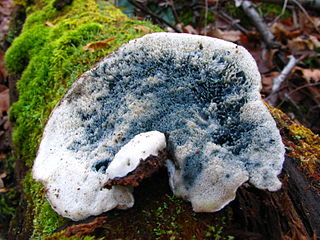Related Research Articles

A hypha is a long, branching, filamentous structure of a fungus, oomycete, or actinobacterium. In most fungi, hyphae are the main mode of vegetative growth, and are collectively called a mycelium.

The Cantharellaceae are a family of fungi in the order Cantharellales. The family contains the chanterelles and related species, a group of fungi that superficially resemble agarics but have smooth, wrinkled, or gill-like hymenophores. Species in the family are ectomycorrhizal, forming a mutually beneficial relationship with the roots of trees and other plants. Many of the Cantharellaceae, including the chanterelle, the Pacific golden chanterelle, the horn of plenty, and the trumpet chanterelle, are not only edible, but are collected and marketed internationally on a commercial scale.
Edred John Henry Corner FRS was an English mycologist and botanist who occupied the posts of assistant director at the Singapore Botanic Gardens (1929–1946) and Professor of Tropical Botany at the University of Cambridge (1965–1973). Corner was a Fellow of Sidney Sussex College from 1959.

The Clavariaceae are a family of fungi in the order Agaricales. Originally the family contained most of the clavarioid fungi, but in its current sense is more restricted, albeit with a greater diversity of basidiocarp forms. Basidiocarps are variously clavarioid or agaricoid (mushroom-shaped), less commonly corticioid or hydnoid.

The Thelephorales are an order of fungi in the class Agaricomycetes. The order includes corticioid and hydnoid fungi, together with a few polypores and clavarioid species. Most fungi within the Thelephorales are ectomycorrhizal. None is of any great economic importance, though Sarcodon imbricatus is edible and commercially marketed, whilst several species have been used for craft dyeing.

The Aphelariaceae are a family of fungi in the order Cantharellales. The family contains a small group of tropical and subtropical clavarioid fungi, but is not well characterized and has not been the subject of published research.

Lentaria is a genus of fungi in the family Lentariaceae. The genus has a widespread distribution and contains 17 species. It was circumscribed by British mycologist Edred John Henry Corner in 1950.

Ramariopsis is a genus of coral fungi in the family Clavariaceae. The genus has a collectively widespread distribution and contains about 40 species. The name means 'having the appearance of Ramaria'.

Physalacria is a genus of fungi in the family Physalacriaceae. The genus contains 30 species widely distributed in tropical regions of the Southern Hemisphere.
Pseudotyphula is a genus of fungus in the family Marasmiaceae. The genus is monotypic, containing the single species Pseudotyphula ochracea, found in North America. The genus was circumscribed by British mycologist E.J.H. Corner in 1953.

Trogia is a genus of fungi in the family Marasmiaceae. It is named after a Swiss mycologist Jacob Gabriel Trog. The genus contains about 20 species that are widely distributed in tropical areas.

Datronia is a genus of poroid crust fungi in the family Polyporaceae. The genus was circumscribed by Marinus Anton Donk in 1966, with Datronia mollis as the type species. Datronia fungi cause a white rot in hardwoods. Datronia contains six species found in northern temperate areas. The most recent addition, Datronia ustulatiligna, was described in 2015 from Himachal Pradesh in India.

Oligoporus is a genus of fungi in the family Polyporaceae. The genus was circumscribed by German mycologist Julius Oscar Brefeld in 1888 with Oligoporus farinosus as the type. This species is currently known as Postia rennyi. The genus name combines the Ancient Greek words ὀλίγος ("few") and πόρος ("pore").

Thelephora is a genus of fungi in the family Thelephoraceae. The genus has a widespread distribution and contains about 50 species. Fruit bodies of species are leathery, usually brownish at maturity, and range in shape from coral-like tufts to having distinct caps. Almost all species in the genus are thought to be inedible, but Thelephora ganbajun is a gourmet fungus in Yunnan province of southwest China.

Clavaria is a genus of fungi in the family Clavariaceae. Species of Clavaria produce basidiocarps that are either cylindrical to club-shaped or branched and coral-like. They are often grouped with similar-looking species from other genera, when they are collectively known as the clavarioid fungi. All Clavaria species are terrestrial and most are believed to be saprotrophic. In Europe, they are typical of old, mossy, unimproved grassland. In North America and elsewhere, they are more commonly found in woodlands.
Allantula is a fungal genus in the family Pterulaceae. The genus is monotypic, containing the singles species Allantula diffusa, found in Brazil. The genus and species were described by British mycologist E.J.H. Corner in 1952.

The Clavariadelphaceae are a family of fungi belonging in what is classically known as the Gomphales order, or cladistically as the gomphoid-phalloid clade. First described by British botanist E.J.H. Corner in 1970, the family has 2 genera and 26 species.

Caripia is a fungal genus in the family Marasmiaceae. The genus is monotypic, containing the single species Caripia montagnei, commonly known as the pod parachute. It is found in tropical and subtropical regions of the Americas. Formerly classified in the Stereales, molecular analysis published in 2002 demonstrated that the fungus is a reduced form of the closely related Gymnopus.
Parastereopsis is a genus of fungi in the family Cantharellaceae. It is a monotypic genus, and contains one species, Parastereopsis borneensis, described as new to science by British mycologist E.J.H. Corner in 1976.
Hygrophoropsis flabelliformis is a species of fungus in the family Hygrophoropsidaceae. It was first described by mycologists Miles Joseph Berkeley and Henry William Ravenel in 1853 as Cantharellus flabelliformis. E.J.H. Corner transferred it to the genus Hygrophoropsis in 1966.
References
- ↑ Corner EJH. (1966). "A monograph of cantharelloid fungi". Annals of Botany Memoirs. 2: 166.
- ↑ Kirk PM, Cannon PF, Minter DW, Stalpers JA (2008). Dictionary of the Fungi (10th ed.). Wallingford, UK: CABI. p. 576. ISBN 978-0-85199-826-8.